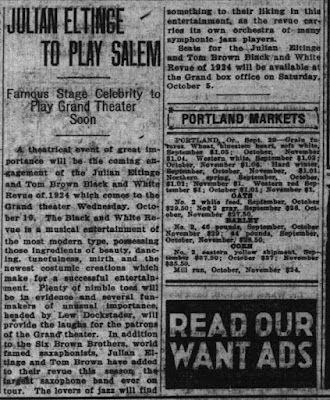100 years ago, Salemites had a chance to see proto-drag performer Julian Eltinge live on stage at The Grand.
 |
| Julian Eltinge, publicity still (New York Public Library) |
 |
| September 30th, 1923 |
Previously there had been some discussion in the papers of him and his performances, but not a great deal of it. The first may have been this piece from New York in 1914.
 |
| March 30th, 1914 |
 |
| December 28th, 1917 |
In 1918 The Oregon theater showed one of his movies here, and the ads pictured him dressed as a woman and underscored not just cross-dressing but also gender crossing. "Can a man mother a baby?" it asked.
 |
| February 19th and 20th, 1918 |
It also promised "a new viewpoint on eugenics."
The film is lost and there is not a lot of information about it. Other newspapers did not pick up a "eugenics" theme, but they did underscore a narrative arc of disruption and restoration.
the story of a young New Yorker who decides to dabble in ranching and narrowly misses being robbed by a notorious crook. How he succeeded in foiling the designs of this gentleman through the disguise of a woman, how the disguise gets him into a lot of trouble with the girl he loves, but how he at length wins out and saves both his girl and the ranch, makes a story of fun and adventure throughout.Another zeroed in on the baby and appears to suggest that the "natural" order was upheld, that a baby knows a "true" mother and would reject a man trying to mother:
Everyone, but the baby in "The Widow's Might,"... might have been deceived by the impersonator's wonderful make up. But not the infant. It, looked at the blond wig with disapprobation and when Eltinge held out his arms for the child, it dissolved in tears—and howls.
On the second day "The Widow's Might" was showing, a front page article displayed anxiety that "coming generations of Americans are endangered by the indiscriminate rush of women into industry," a change in no small part prompted by the loss of men to the military in World War I.
 |
| February 21st, 1918 |
It was a time of anxiety about sex and gender. The 19th Amendment would be ratified just two years later. As I read those fragments, and a few others, on "The Widow's Might," the film's intended conclusion was the restoration of properly ordered gender in society.
 |
| October 3rd, 1923 |
Our performance in 1923 also had elements of minstrelsy. "The Julian Eltinge and Tom Brown Black and White Review of 1924" featured the Six Brown Brothers and Lew Dockstader, all of whom featured blackface and minstrelsy in their performances.
 |
| June 10th, 1887 |
In fact, the very first reference I found to "female impersonation" here was in a minstrel show two generations earlier.
Minstrelsy appeared much more often and regularly in Salem. When female impersonation on stage is mentioned, it seems to have a context of skit, parody, even the temporary role-reversal in carnival, and does not seem to be a sustained project and career like that of Eltinge's. Eltinge meant also to pass or to be able to pass, and generally the other performers rely on caricature, on being obviously cross-dressed. Blackface, too, was about not-passing, about obvious stereotype and parody.
 |
| April 10th, 1905 |
 |
| December 22nd, 1911 |
 |
| September 6th, 1915 |
In his book, Re-Dressing America's Frontier Past, which I was not able to consult in full for this, Peter Boag mentions Eltinge, the minstrelsy context — and so much more. He argues that "cross-dressers were not simply ubiquitous, but were very much a part of daily life on the frontier and in the West," and asks, "how and why did such a large group of people so visible and so much a part of daily life in the nineteenth-century West become so forgotten that their rediscovery was such an unexpected thing?"
 |
| Re-Dressing America's Frontier Past - Peter Boag |
A recent short at PBS, part of their "Masters of Drag" series, "Julian Eltinge: Female Impersonator of the Vaudeville Era," which has some vintage clips of Eltinge performing, acknowledges ambiguity in Eltinge's performance, calling him a "pioneering American drag artist" and interpreting him as part of drag history, but more often using "female impersonator," since drag as we know it today is significantly different in important ways and exists in a different cultural matrix. But when you look at the clips, it's hard to say there wasn't an element of camp to Eltinge's performance, even when he was also intent on being able to pass.
 |
| January 26th, 1923 |
It is worth highlighting Eltinge's visit and the density of promotion for it as particularly notable. Earlier in 1923 there was another instance of female impersonation by Cecil North, but
it got much less press. Substantial advance notice for Eltinge appeared
on September 30th (at top), October 3rd (photo above), October 4th, twice on October 5th and here, and on the day of the show. His performance seemed to be a big deal. It was also part of a long-term artistic project and presentation of self, and by an order of magnitude or more was greater than intermittent skit performances.
There is surely more to say, and experts will be able to tease out greater and more subtle significance. If we come across more about how Salemites received Eltinge, as opposed to the advance press and hype, there might be more to say also.


No comments:
Post a Comment